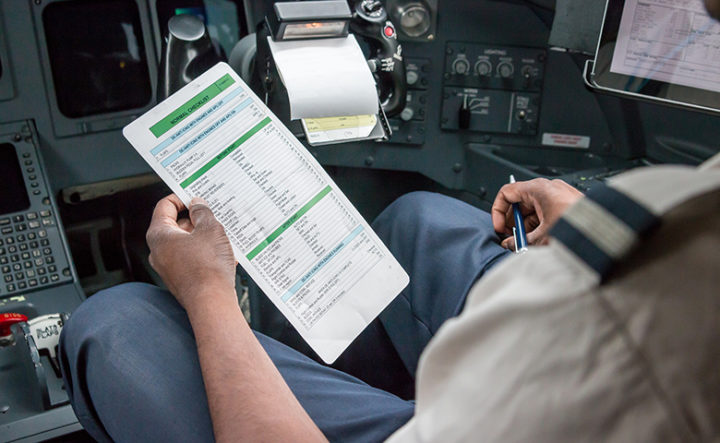Success in injury prevention often comes from having a good safety routine. Adopting a steady workplace operations schedule keeps everyone on task and working toward the same goals. Once a new routine is established, it will become a habit (and it can eliminate old bad habits that might have been formed). But what happens when you do everything right but overlook the smallest thing? In some professions, overlooking that little thing can be catastrophic.
That’s why checklists are so important—they can help build new habits while making sure that small but essential tasks don’t fall through the cracks. And even the most basic checklist can improve effectiveness in any industry. As Atul Gawande notes in his book The Checklist Manifesto: How to Get Things Right, knowledge has become more accessible over the last several decades. Where ignorance used to be an acceptable (and more forgivable) reason for failure, declining to correctly apply knowledge is simply unforgivable. “Failures of ignorance we can forgive. If the knowledge of the best thing to do in a given situation does not exist, we are happy to have people simply make their best effort. But if the knowledge exists, and is not applied correctly, it is difficult not to be infuriated,” Gawande says.
Creating structure in the work environment helps to ensure that everyone is following all of the prescribed functions of their job. Once functions are performed enough times, they will become a habit. Habits can help workers complete tasks even when their minds aren’t on the task at hand, but like memory, habits aren’t infallible. Implementing a checklist, even for the most routine tasks, is the key to reducing (or eliminating) injuries and critical mistakes.
Implement a safety checklist

The aviation industry is well-known for using checklists—pilots rely on them for safety and emergency preparedness, and those checklists are often the difference between life and death. The same is true for surgeons. Missing a step for them is not as forgivable as, say, forgetting materials on a construction site.
It’s common to rely on knowledge, skills and routine to get through daily tasks, but it’s easy to overlook how certain states of mind like complacency, fatigue or rushing could cause you to forget or miss a vital step in the process. No matter how high your expertise level may be, a well-designed checklist can be beneficial to everyone.
Even if you don’t oversee a team of pilots or surgeons, managers know that when members of their team make a mistake in the workplace, it can lead to injury, downtime, lost production and lost revenue. This means that minimizing errors, especially those related to overreliance on memory, should be a priority.
It’s proven that the dangers of physical hazards can be reduced through engineering solutions and administrative work practices like checklists. By design, checklists are meant to keep people organized and on task. They ensure that things are not forgotten and when completing repetitive tasks (where complacency can set in) they confirm a task is being done the right way—every time.
In his book, Gawande outlines two types of checklists—DO-CONFIRM or READ-DO. DO-CONFIRM checklists are meant for jobs that are performed from memory or experience and the checklist is used to confirm everything was done correctly. A READ-DO checklist is meant for people to carry out the tasks as they read them from the list and then check them off as they complete them.
Gawande also noted that checklists should not be lengthy, with between five and nine items per list (which he suggested is the limit of the working memory). He suggests that checklists should only document the necessary steps. While READ-DO lists can work in some capacity, in safety sometimes longer DO-CONFIRM lists are necessary.
When it comes to safety, checklists play a vital role—they can take a program from reactive to proactive, which is essential when it comes to safety prevention. Checklists are common safety documents and once completed they are often kept as a formal record. These records allow employers to track and monitor workplace injuries and illnesses on an ongoing basis. But it’s important to consciously know how to use them properly. You can use the information collected from a checklist to create internal benchmarks that, in the long run, contribute to the creation of a plan to improve behaviors, eliminate hazardous conditions and reduce work-related injuries.
To-do lists

To-do lists are the most common type of checklist. They outline everything that needs to happen to stay on task, but they do not have a particular order in which they need to be performed. These can include long-term goals or tasks that need to be completed, but won’t necessarily get done immediately. The great thing about a to-do list is that you can check things off as you get to them since one item is often not dependant on another. Work functions often go on to-do lists to ensure a job is being performed properly. When a task isn’t completed consistently, a to-do list can provide a reminder of the process that may have been forgotten over time.
General inspections are supposed to identify issues that have been overlooked on a day-to-day basis, often because of complacency. But since months can pass between inspections, a to-do checklist is the right format to ensure that everything is being properly inspected. Health and safety inspections ensure that the employer has established and maintains a good safety program and covers things like hazard identification/analyses, designated substances, material handling, PPE (use, fit, maintenance, replacement), availability of fully-stocked first aid kits/qualified first aiders on site, fully charged fire extinguishers and access to necessary emergency equipment (eyewash stations, showers).
Inspection checklists, when used correctly, create a written record and provide clear documentation showing the date of the last inspection, outline that the safety procedure was followed and detail any corrective actions that needed to take place.
Training checklists ensure that the training being provided is necessary (it provides the required knowledge and skills for workers to be competent on the job). These are considered a to-do list because they can become a running long-term list. It’s not enough to provide the training—it also needs to be evaluated regularly. Each job position should have their training reviewed at least annually, looking for legislative updates, new or modified equipment, and changes within the job. Refresher training should also be delivered when necessary. An MSDS checklist is another example of a to-do list that provides a starting point for a product’s safe handling practices and procedures.
Task checklist

A task checklist is similar to a to-do list but it’s a procedural checklist that needs to be completed in a particular order. When you think of a checklist, you’re probably thinking of a task checklist. Pre-startup inspections can determine if there is something wrong with the equipment before work begins and are considered task checklists, as all things need to be checked in order before work can begin.
An emergency evacuation checklist is another task checklist that must be completed in a particular order because time is of the essence. These steps can be easily overlooked without a checklist because you’re processing them so quickly.
Troubleshooting checklist

To avoid injuries you first need to think ahead to what is going to cause them, and that’s exactly what a troubleshooting checklist does. A troubleshooting checklist is similar to a task checklist but instead of outlining the procedure, it anticipates what to do if that procedure goes wrong. Determining the right questions to ask and developing an appropriate plan of action, including the timeframes and the names and roles of responsible persons, will ensure that a safe built environment is maintained for all people, regardless of ability.
Preventive maintenance is predetermined work scheduled to avoid the wear and tear or sudden failure of equipment. This would be considered a troubleshooting checklist since a number of things need to be performed to avoid equipment failure.
Coordination checklists

A coordination checklist is designed to help in a situation where multiple people are working on one task or assignment. It has a section for each specialized trainer. These are especially helpful in big companies. A job hazard analysis could be considered a coordination checklist since each job is broken down into specific tasks to reduce the risk of injury to workers.
Management checklists

Checklists aren’t just for workers. Management also requires a set of checklists to avoid making critical errors. Make sure that employees know that you have your own set of checklists to follow, as this will help them recognize that the entire organization values and uses checklists, and will make your own operations more transparent to workers.
If you need to create your own checklists, templates are a good place to start but remember that they need to be tailored to your site’s specific needs. Do not create a laundry list for the sake of looking accomplished. Only include the steps necessary to successfully complete your tasks.
Turn employee actions into habits

It’s important to recognize the limits of checklists. You can follow all of the things on your checklist, but if you’re not truly engaging your employees in conversation, you’ll lose them. Examining the written record provides a plan for prevention and keeps people accountable. However, a discussion with the inspector, supervisor, and safety manager should determine a course of action and will prevent someone from blindly checking boxes in an effort to just get it done. While not all steps seem critical if missed, the repercussions of missing them are often noticed when they affect the outcome of another function.
Combining checklists with one-on-one or small-group engagement will help you create a positive and effective team atmosphere. Conversations with workers will also help you ensure that checklists are doing their part in turning actions into habits. When used properly, safety checklists are a key component in reducing injuries and keeping workers focused on safety and effectively completing the task at hand.

